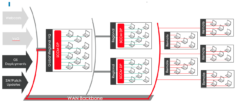3 Roadblocks Keeping You From Corporate Video Success
CMMA BlogWhen it comes to enterprise video, internal communications teams always begin with the best of intentions. They envision live video being used to connect corporate leaders with offices around the world so the CEO can deliver her vision live instead over email. Or perhaps they envision a vast on-demand library of training videos that staff can use to level up their skills and unleash a wave of innovation that propels the company to new heights.
However, when it comes to success, good intentions are rarely enough. The excitement from launching an enterprise video strategy can quickly peter out if the performance of the video content is merely meh.
In our experience, a poorly-performing video strategy often comes down to three roadblocks: poor content, poor deliverability, or poor insights. For video success, you need to create compelling content, deliver it, and then measure performance so you can continue to improve.
That’s where an analytics platform like Kollective IQ comes in. With Kollective IQ, you can break down the performance of your videos and your network in detail so you can overcome roadblocks to your success.
Roadblock #1: Poor Quality Content
The quality of your content can either be the easiest or the most difficult roadblock to overcome in your path to corporate video success. Quality is subjective. What the CEO might consider a fascinating topic for an all-hands town hall video might be considered painfully dull by the staff. Meanwhile, training materials that are out of date or unengaging may be keeping staff from learning important skills or information, making it at best counterproductive and at worst actively damaging to your business.
While quality is subjective, you can use analytics to at least figure out where you are losing viewers. Kollective IQ lets comms teams look at their video events and on-demand library performance at the individual video level by the minute, helping you understand not only how many people watched the event, but when they stopped watching it.
If you’re noticing staff dropping from an hour-long town hall video after a few minutes, it’s then worth looking at the content itself to see what you can do to make it more engaging. Remember, a video audience is not the same as an in-person audience; where an audience in an auditorium is stuck with a poor presentation, the live video audience is highly distractible, likely has other work open on their screen, and is just a click away from closing the video app altogether.
Similarly, if you notice viewers quitting an on-demand video before the end, it’s worth looking at the spot where you lose viewers to see if the content is too difficult or too simplistic to be worth continuing to watch.
Roadblock #2: Poor Deliverability
The best content in the world is worthless if it doesn’t make it to the viewer or if there’s a poor viewing experience once it gets there.Video is a data-intensive application. When thousands of employees are all watching a live CEO town hall, it has the potential to grind the network to a halt. This not only impacts video performance; it also impacts the deliverability of your other critical business applications and data, compounding the impact of poor network performance.
Comms teams and their IT counterparts can use Kollective IQ to analyze network performance in a number of ways. For example, each video can be looked at to see the buffering time viewers experience while watching the video. A live video with a high amount of buffering indicates a bottleneck in the network that needs to be addressed. By reducing buffering, you’ll be able to improve the viewing experience while improving the deliverability of other business data.
Kollective IQ also helps teams understand the peering efficiency of their video content. The more your content is delivered by a peer instead of by a distribution point, the more you free up the network to deliver other data. A video with low peering efficiency indicates an issue in your network that needs to be fixed.
Roadblock #3: Poor insights
When it comes to analytics, capturing data is key. However, data collection is just the beginning and understanding what the data is trying to tell you is key. When it comes to video analytics, too many solutions only provide basic data about video performance without offering any insight into why it happened or what to do about it.
Kollective IQ’s performance dashboard uses data visualization to serve up instant insights into video performance in real time. If a live video is experiencing poor deliverability, you can know about it and fix it before you lose viewers.
Similarly, you can use your analytics to understand macro-performance of your entire video strategy, drill down into specific videos to review their performance, or even look at individual users to understand who watched what video when and for how long. You can easily set up automatic reports to be delivered to your email, or push the data out to other analytics platforms like Power BI or Tableau to tie video performance to business performance.
Getting the metrics that matter to your team in the right format and at any time has never been easier. Download the Kollective IQ Solutions Brief to learn more about how Kollective IQ can help you overcome enterprise video roadblocks.
ONE PLATFORM, MULTIPLE SOLUTIONS
Solve the most complex network traffic problems with a single platform that enables you to deliver Live Video, VOD, and Software Updates – with efficiency and ease.
Related Blog Posts
5 Ways Your Enterprise Company Could Benefit from Video All-Hands Meetings
Town hall meetings. Round-ups. All-hands meetings. Whatever your company calls it, most businesses have some iteration of the all-hands meeting, which exists to keep employees at all levels in the loop on current initiatives, progress, growth and company news. These…
Are Distribution Points Holding Your Remote Offices Back?
When it comes to large, distributed enterprises like retailers or banks, every location has its own data challenges to overcome. Tier 1 locations, like a global headquarters, can have thousands of employees in one building, while some large corporate campuses may…
3 Roadblocks Keeping You From Corporate Video Success
When it comes to enterprise video, internal communications teams always begin with the best of intentions. They envision live video being used to connect corporate leaders with offices around the world so the CEO can deliver her vision live instead over email. Or…
The post 3 Roadblocks Keeping You From Corporate Video Success appeared first on Kollective Technology .





